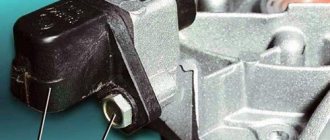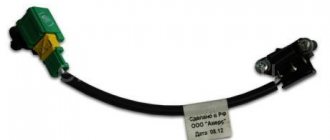Many problems in cars happen due to improper care of the owner of his own vehicle. After all, every car, like a person, requires many needs for full functioning. Car enthusiasts often miss such moments. Accordingly, the machine is damaged and becomes vulnerable to more and more errors and malfunctions. Therefore, in order to avoid bad consequences for the car, you should carry out full maintenance on it more often and supply it with the necessary materials to ensure that the car lasts as long as possible.
What does P0036 mean?
Trouble code P0036 is a general trouble code that indicates that the engine control module (ECM) has detected a malfunction in the oxygen sensor 2 (bank 1) heater circuit. The vehicle's ECM uses an oxygen sensor to monitor the oxygen content of the vehicle's exhaust gases. The ECM uses the signal received from the oxygen sensor to regulate the fuel/air mixture ratio of the engine. The most optimal ratio of air and fuel in the mixture supplied to the engine cylinders is 14.7:1. It is this ratio that is necessary to achieve maximum engine power and optimal fuel consumption.
The oxygen sensor heater is used to heat the internal components of the oxygen sensor to provide faster feedback to the vehicle's ECM. This is necessary to reduce emissions of harmful substances from vehicle exhaust gases when starting and warming up the engine.
in our VKontakte group
DIAGNOSE YOUR CAR YOURSELF!
Electrically heated oxygen sensors are used for fuel monitoring and post-catalyst monitoring. Each HO2S sensor compares the oxygen content of the ambient air with the oxygen content of the exhaust gases. When the engine is first started, the ECM operates in open-loop control mode, ignoring the HO2S signal level when calculating the air/fuel ratio. The ECM supplies the HO2S sensor with a control signal level of approximately 0.45 V. The HO2S sensor generates a signal level within 0
1V, which when operating in a closed loop fluctuates above and below the bias voltage. A high HO2S sensor output indicates a rich fuel mixture. A low HO2S sensor output indicates a lean fuel mixture. Heating elements in the HO2S sensor minimize the time it takes for the sensors to reach operating temperature and then transmit an accurate voltage signal. The ECM monitors the HO2S heater low signal circuit by using a control device on the low circuit. The HO2S Heater Diagnostic System monitors the flow of current through the control device into the low HO2S circuit while the engine is running. When the ECM detects that the HO2S heater control circuit current exceeds a preset level, a DTC is set.
Conditions for the DTC to Occur
The HO2S heater PWM reaches 98% after cranking. When checking the equipment, no malfunction of the HO2S sensor was detected. (0.8S) Air flow ranges from 4 kg/h to 40 kg/h. (1.0S) Air flow ranges from 6 kg/h to 40 kg/h. Battery voltage is between 11.07 V and 15.47 V. Predicted catalytic converter temperature is greater than 300°C (572°F).
Conditions for Setting the DTC
HO2S heater resistance is less than 3 ohms or greater than 35 ohms.
Action Taken When the DTC Sets
The malfunction indicator lamp lights up. The controller records the operating conditions at the time the fault is detected. This information is stored in a status record buffer and fault logs. An archive of diagnostic trouble codes is saved.
Conditions for Clearing DTC/Malfunction Indication
The malfunction indicator lamp turns off after 3 consecutive test cycles have completed without failure. The historical DTC clears after 40 heat cycles without failure. The DTC can be cleared by a scan tool.
Diagnostic guidelines
The numbers below refer to the operation numbers on the diagnostic table: This step tests the heater control circuit for high resistance. If the voltage is higher than specified, you need to check the circuit for high resistance.
Causes of error P0036
The P0036 code will appear if the vehicle's ECM detects that the O2 Sensor 2 (Bank 1) heater circuit voltage is too low or too high (compared to the manufacturer's specification). The most common causes of this error are a malfunction of the heated oxygen sensor, as well as damage to the associated electrical wires or connector. In rare cases, the problem may be a faulty engine control module (ECM).
Diagnostics using third-party equipment
More precisely, errors on Chevy Niva can be identified by connecting additional equipment. The technique is more technically complex, but allows us to determine the cause of a breakdown or failure with minimal error. In this case, the sequence of actions is as follows:
If all actions are performed correctly, all available information and any errors in the form of encrypted codes will be displayed in the desktop window.
There are also specialized scanners designed specifically for Chevrolet NIVA. Dealer devices are connected to the place of the standard signaling unit through an output cable.
Separately, we should highlight modern devices designed to connect a smartphone to a car, while reading encodings and controlling operating modes occurs directly from the gadget’s display.
At the same time, you should know what the encodings displayed during diagnostics mean. The code consists of several elements.
The next element is a single digit:
The following digit determines the exact serial number of the line in which the defect was detected:
What are the symptoms of P0036?
When this error occurs, the Check Engine light on the vehicle's dashboard will light up, indicating a malfunction. The engine control module (ECM) may place the vehicle in limp mode until the problem is corrected. If the oxygen sensor heater fails, the vehicle's ECM may not receive feedback from the oxygen sensor for the first 2 to 5 minutes of engine operation. This will cause the ECM to be unable to adjust the engine's air/fuel ratio properly until the problem is corrected.
Is the P0036 code problem serious?
If the “check” light is on, contact the workshop immediately. Don't expect the problem to go away on its own. The longer the moment of recovery is missed, the more likely the problem will become much more serious. After all, this error consumes a lot of fuel and affects other elements of the car.
Error P0036 is considered problematic in cars not because it is so serious, but because it gets worse over time. That is, if you eliminate the problem as soon as it appears, then it is not terrible at all. But otherwise, it will only gain momentum and become global and difficult to correct.
How does a mechanic diagnose a P0036 code?
First, the mechanic reads all the stored data and error codes using an OBD-II scanner. He will then clear the error codes from the computer's memory and test drive the vehicle to see if the P0036 code appears again. If the error code appears again, the mechanic will visually inspect the heated oxygen sensor for damage, as well as check the ground and measure the voltage at the sensor. The mechanic will then carefully check any associated electrical wires that may have been damaged due to excessive heat due to high exhaust temperatures.
How to install a fake instead of an oxygen sensor on a Lada Granta
Before installing a lambda probe emulator, let’s figure out why this is done and what the theoretical justification for this operation is. As a rule, when removing the catalyst or one of the oxygen sensors, the ECU is flashed. This is not always included in our plans, especially since it can be difficult to find a competent master in this area. Therefore, we will deceive the engine’s brains without flashing it.
The first oxygen sensor is initially supplied with about 3 VDC. As the engine warms up, a pulse current of 0.1-0.9 Volts with a frequency of 1-2 Hz appears on the contacts of DK1. At this time, a pulse signal of the same frequency 0.6-0.8 Volt , but with a phase shift. This occurs due to the inertia of the catalyst. Without going into the intricacies of circuitry and radio electronics, we need to emulate the signal from oxygen sensor 2 so that the ECU does not notice its absence. There are at least two paths you can take to install the decoy without firmware.
We remove the oxygen sensor on the Lada Granta. Method one, for the lazy
To install a simple snag instead of a lambda, all you need is a soldering iron and straight arms. In addition, buy two resistances from a radio parts store:
- 330 Ohm resistor to simulate the operation of the sensor heating filament.
- 100 kOhm resistor .
You also need to buy a 4-pin DC connector. Now we solder the resistances crosswise, according to the diagram below. First, we put on heat shrink insulation. We solder a 100 kOhm to contacts A and C of a 300 ohm resistance to solder contacts B, D. The contact markings are on the connector body. The result should look something like this.
The deception is ready. All that remains is to install it on the wiring harness and secure it under the bottom. The hole for the lambda probe can be plugged or the old sensor can be left in place. As a result, the system will interrogate our stray and mistake it for an oxygen sensor installed after the catalyst. If you connect a scanner and look at the operation diagram of both sensors, it will look like this.
After this simple operation, error P0036 will no longer bother us. However, there is a more reliable way to install the emulator.
Install an oxygen sensor emulator. Method two, reliable
The principle of operation of the emulator is essentially the same, but it responds to requests from the engine control system more accurately and eliminates errors. True, it is a little more difficult to assemble. But for those who are comfortable with a soldering iron, there will be no problems. To assemble the device we will need:
- Variable resistance at 100 kOhm .
- Resistors 1 kOhm, 620 kOhm, 200 Ohm .
- Two 20 µF electrolytic capacitors.
- A simple printed circuit board.
Oxygen sensor emulator circuit
As in the previous case, a 200 Ohm resistor is placed on pins B and D to emulate the oxygen sensor heating filament. The assembled device looks like this.
We place it in any suitable housing and place it under the bottom. The oxygen sensor can be unscrewed and replaced with a plug with an 18x1.5 thread. In this way, you can eliminate error P0036 on Lada Granta engines with your own hands.
Source
How serious is P0036?
When a P0036 error occurs, the Check Engine light on your vehicle's dashboard will illuminate, indicating a problem. Failure of the heated oxygen sensor may cause the vehicle's ECM to not be able to properly regulate the fuel/air mixture in the engine. The vehicle's engine may run erratically. It may also increase fuel consumption and damage other vehicle components. If this code is detected, it is recommended that you contact a qualified technician as soon as possible to diagnose and resolve the error.
Often, if the Check Engine Light comes on immediately after starting the engine, the OBD-II system can be reset and the vehicle will continue to operate normally.
in our VKontakte group
DIAGNOSE YOUR CAR YOURSELF!
Electrically heated oxygen sensors are used for fuel monitoring and post-catalyst monitoring. Each HO2S sensor compares the oxygen content of the ambient air with the oxygen content of the exhaust gases. When the engine is first started, the ECM operates in open-loop control mode, ignoring the HO2S signal level when calculating the air/fuel ratio. The ECM supplies the HO2S sensor with a control signal level of approximately 0.45 V. The HO2S sensor generates a signal level within 0
1V, which when operating in a closed loop fluctuates above and below the bias voltage. A high HO2S sensor output indicates a rich fuel mixture. A low HO2S sensor output indicates a lean fuel mixture. Heating elements in the HO2S sensor minimize the time it takes for the sensors to reach operating temperature and then transmit an accurate voltage signal. The ECM monitors the HO2S heater low signal circuit by using a control device on the low circuit. The HO2S Heater Diagnostic System monitors the flow of current through the control device into the low HO2S circuit while the engine is running. When the ECM detects that the HO2S heater control circuit current exceeds a preset level, a DTC is set.
What repairs can fix the P0036 code?
To resolve error P0036 you may need to:
- Clearing error codes from the ECM and test driving the vehicle to see if the P0036 code appears again
- Heated Oxygen Sensor 2 (Bank 1) Replacement
- Repair or replace electrical wires or connector for heated oxygen sensor 2 (bank 1)
- Replacing the fuse in the oxygen sensor 2 heater circuit (bank 1)
- In rare cases, replacing the engine control module (ECM)
Additional comments for troubleshooting P0036
Many high mileage vehicles (usually over 150,000 kilometers) have short-term problems with sensors, which usually occur when the engine is started or the transmission is subjected to prolonged stress. Often, if the Check Engine Light comes on but the vehicle continues to operate normally, the OBD-II system can be reset and the problem will be resolved. This is why it is important to check for an error code using a scanner and clear the code from the computer's memory before performing any repair work.
Chevrolet Niva error codes: decoding and description of meanings
The popular Russian-made model is very widespread in the CIS countries due to its optimal cost and increased cross-country ability, which is critically important in the conditions of domestic operation.
Motorists buy cars for off-road travel and small towns, where the quality of roads leaves much to be desired. The disadvantages of the car include weak wiring - when the load increases to the design limit, on-board electronic systems often fail, which causes software failures. Chevy Niva error codes appear on the dashboard display or are detected using special equipment, but the common thing is that they all indicate a malfunction of a specific component.











